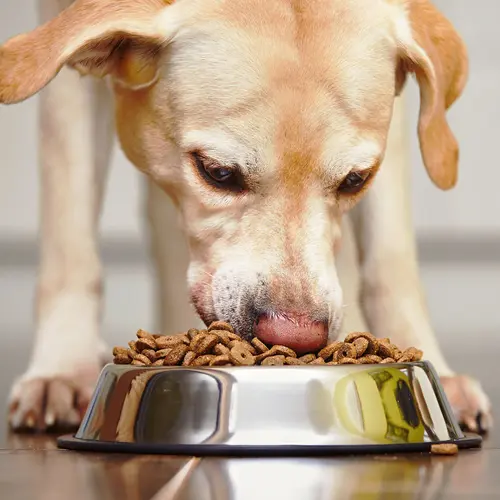What Is Famotidine?
Famotidine (Pepcid) is a medicine classified as an H2 blocker. It reduces the amount of acid that is in your pet’s stomach. It is used to treat and prevent ulcers (open sores) in the esophagus, throat, stomach, and intestines. It is most effective for short-term use, especially around operations where there is a risk of acid reflux. Other medicines such as omeprazole have been shown to be more effective for longer-term use.
All uses for famotidine in pets are considered to be “off-label” or “extra-label.” This means that there may be evidence of safe and effective use but the FDA has not approved that use.
There is no veterinary-specific formulation for dogs or cats. The human medicine, which can be used in animals, is available in oral tablets, a liquid, and an injection. Famotidine tablets are available over-the-counter (OTC) without a prescription. The oral liquid requires a veterinary prescription and is available from human pharmacies. The injectable form is only used in veterinary hospitals. Since none of these products are formulated specifically for animals, discuss this with your veterinarian so that you get the right amount for your pet. Contact your veterinary compounding pharmacy for alternative dosing options.
How Is Famotidine Used in Pets?
Famotidine is usually given by mouth twice a day as directed by your veterinarian. It can also be given by injection in the veterinary hospital. Famotidine works best if given on an empty stomach. If vomiting occurs, try giving it with a small amount of food or a treat.
The oral liquid should be shaken well and correctly measured using the provided dosing dropper or syringe before giving. Slowly give liquid medicines into a pet’s mouth so that they receive all of the dose.
Always follow your veterinarian’s directions for giving medicines to animals. Remember to tell your veterinarian about any medicines, vitamins, supplements, or herbal therapies that you are giving your pet. Talk to your veterinarian before stopping any pet medicines.
What Are the Benefits of Famotidine in Pets?
- Famotidine is usually well-tolerated in dogs and cats.
- Famotidine is quick-acting and should start working in 1 to 2 hours.
- Famotidine works well on the first day, where other medicines like omeprazole may take longer to start working.
What Follow-up Is Required With Famotidine?
You and your veterinarian should monitor your pet for improvement of their condition, as well as for side effects of the medicine. There are usually no routine blood tests that need to be performed.
Does Famotidine Have Warnings or Side Effects in Pets?
Do not use famotidine in animals that are allergic to it. Use famotidine with caution in animals with kidney disease. Famotidine appears to be safe when used in pregnant animals, but caution is always advised. Famotidine enters the breast milk, so caution is advised in nursing animals.
Famotidine is well-tolerated in dogs and cats. Side effects of oral famotidine are usually mild and usually only include constipation or diarrhea. Contact your veterinarian if either of these worsens or continues for a few days.
Intravenous (IV) famotidine can lower the heart rate if given too quickly.
If side effects persist with famotidine, stop the medicine and contact your veterinarian. Your veterinarian will discuss treatment options depending on the side effects and may recommend switching to a different medicine.
If you suspect that your pet is having a serious side effect or may have been overdosed, call your veterinary clinic immediately. If it is outside of regular office hours, you may contact a local emergency veterinary hospital or an animal poison control center.
You can reach the ASPCA Animal Poison Control Center at 888-426-4435 or the Pet Poison Helpline at 855-764-7661.
Does Famotidine Interact With Other Medicines?
Using multiple medicines can sometimes change how your pet’s medicines work or increase your pet’s risk for serious side effects. Always tell your veterinarian about any prescription or over-the-counter (OTC) medicines, vitamins/minerals, herbal products, and other supplements that your pet is using.
In particular, make sure that you discuss if your pet is using any of the following before using famotidine.
“Azole” antifungals. Certain medicines to treat fungal infections are called “azole” antifungals. Common examples include fluconazole, itraconazole, and ketoconazole. These medicines are affected by the pH (acidity) of the stomach. Separate doses of famotidine and oral azole antifungals by at least 2 hours.
Cephalosporins. Certain medicines to treat bacterial infections are called cephalosporins. Common examples include cefpodoxime, cefuroxime, and cephalexin. These medicines are affected by the pH (acidity) of the stomach. Separate doses of famotidine and oral cephalosporins by at least 2 hours.
Iron. When given with famotidine, the absorption of iron from supplements can be decreased. Separate iron supplement and famotidine doses by at least 1 hour.
This may not be a complete list of medicines that can interact with famotidine. Always check with your veterinarian.
Are There Safety Concerns for Pet Owners?
- Keep famotidine out of reach of children.
- Wash your hands after giving famotidine to your pet.
- Do not handle famotidine if you are allergic to it.
What If My Pet Takes Too Much Medicine or Has an Overdose?
To prevent accidental swallowing of the medicine, the package should be stored in a secure location out of reach of the pet. If you think your pet has taken more famotidine than prescribed, call your veterinarian or veterinary emergency clinic immediately.
What If My Pet Misses a Dose?
If your pet misses a dose, you can give that dose if it is close to the original scheduled time. If it is closer to the next dosing time, skip the missed dose completely and give the next dose at the correct time. Do not double the dose of the medicine.
How Do I Store Famotidine?
Oral famotidine should be protected from light and kept at room temperature. Do not store the oral liquid in the refrigerator or freezer. The injectable form should be stored in the refrigerator but not frozen.

